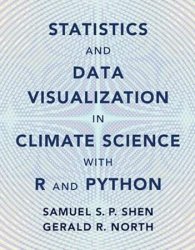Statistics and Data Visualization in Climate Science with R and Python
- Добавил: literator
- Дата: 20-11-2023, 15:30
- Комментариев: 0
 Название: Statistics and Data Visualization in Climate Science with R and Python
Название: Statistics and Data Visualization in Climate Science with R and PythonАвтор: Samuel S. P. Shen, Gerald R. North
Издательство: Cambridge University Press
Год: 2023
Страниц: 415
Язык: английский
Формат: pdf (true)
Размер: 35.5 MB
A comprehensive overview of essential statistical concepts, useful statistical methods, data visualization, and modern computing tools for the climate sciences and many others such as geography and environmental engineering. It is an invaluable reference for students and researchers in climatology and its connected fields who wish to learn data science, statistics, R and Python programming. The examples and exercises in the book empower readers to work on real climate data from station observations, remote sensing and simulated results. For example, students can use R or Python code to read and plot the global warming data and the global precipitation data in netCDF, csv, txt, or JSON; and compute and interpret empirical orthogonal functions. The book's computer code and real-world data allow readers to fully utilize the modern computing technology and updated datasets. Online supplementary resources include R code and Python code, data files, figure files, tutorials, slides and sample syllabi.
Machine Learning (ML) is a branch of science that uses data and algorithms to mimic how human beings learn. The accuracy of ML results can be gradually improved based on new training data and algorithm updates. For example, a baby learns how to pick an orange from a fruit plate containing apples, bananas, and oranges. Another baby learns how to sort out different kinds of fruits from a basket into three categories without naming the fruits. Then, how does ML work? It is basically a decision process for clustering, classification, or prediction, based on the input data, decision criteria, and algorithms.
Our materials will help readers understand and improve the more complex ML algorithms used in climate science, so that they can go a step beyond only applying the ML software packages as a black box. We also provide R and Python codes for some basic ML algorithms, such as K-means for clustering, the support vector machine for the maximum separation of sets, random forest of decision trees for classification and regression, and neural network training and predictions. Artificial Intelligence (AI) allows computers to automatically learn from past data without human programming, which enables a machine to learn and to have intelligence. Machine Learning is a subset of AI. Our chapter here focuses on ML, not general AI.
Скачать Statistics and Data Visualization in Climate Science with R and Python
Внимание
Уважаемый посетитель, Вы зашли на сайт как незарегистрированный пользователь.
Мы рекомендуем Вам зарегистрироваться либо войти на сайт под своим именем.
Уважаемый посетитель, Вы зашли на сайт как незарегистрированный пользователь.
Мы рекомендуем Вам зарегистрироваться либо войти на сайт под своим именем.
Информация
Посетители, находящиеся в группе Гости, не могут оставлять комментарии к данной публикации.
Посетители, находящиеся в группе Гости, не могут оставлять комментарии к данной публикации.
